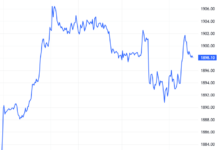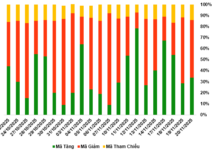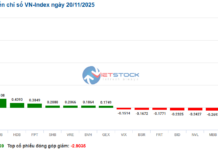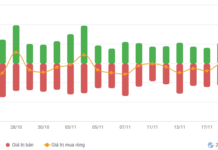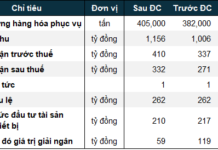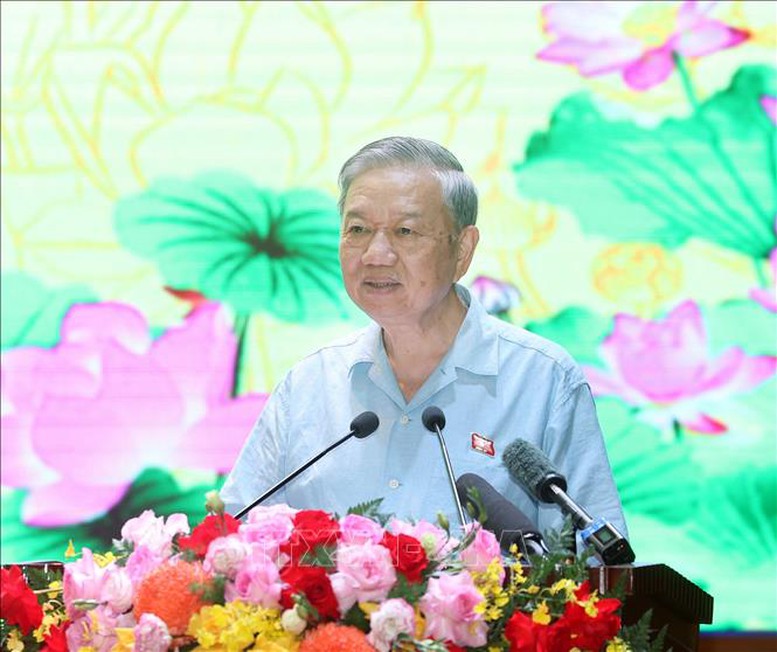
General Secretary To Lam emphasizes the state’s responsibility to ensure fair and efficient land use rights for all citizens. Photo: VNA.
Previously, the General Secretary also held discussions with relevant agencies on the direction of amending the Land Law. According to the General Secretary, the state must ensure fair and efficient land use rights for all citizens, guarantee effective land use, and allocate land value equitably to avoid waste. It is essential to maximize the efficiency of land resources for national development.
The General Secretary’s statement is not merely a practical observation but also highlights a core principle in Vietnam’s land management. This concise remark opens up a significant theoretical and practical issue: under the condition that land is owned by the entire people and managed uniformly by the state, mechanically allowing land prices to follow the market is not only incorrect in principle but also poses numerous dangerous consequences.
To understand this clearly, a deep analysis is required from the perspectives of ownership, economics, and public policy.
Land Ownership – A Unique Vietnamese Perspective
Unlike many countries that recognize private land ownership, Vietnam’s Constitution asserts that land belongs to the entire people, with the state acting as the representative owner and unified manager. This creates a fundamental difference in how land prices are formed.
In a typical market economy, land prices are shaped by competition among numerous private owners. With diverse supply and demand, prices are established on a foundation of genuine competition. However, in Vietnam, the state is the sole supplier in the primary market. All land access needs must go through state decisions on land allocation, leasing, and changes in land use purposes. In other words, Vietnam’s land market is unique, with the state acting both as the supplier and the regulator.
In this context, if the state completely delegates land pricing to local authorities based on the market, it essentially leaves the process vulnerable to speculation, brokerage, and special interest groups. As a result, land prices no longer reflect actual usage value but are distorted by speculative expectations. This is the root cause of paradoxes: many idle lands have sky-high prices, businesses struggle to access land, and speculators profit from price differences.
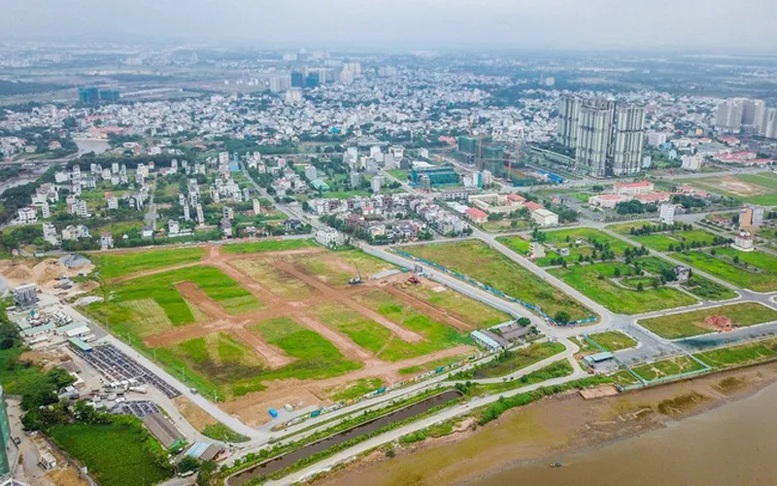
Vietnam’s land market is unique, with the state acting both as the supplier and the regulator.
Risks of Imposing “Market-Based Pricing”
When a public asset owned by the entire people is subject to market-based pricing, several serious risks can arise.
First, irrationally inflated land prices. Even unverified information about planning or infrastructure can trigger a “land fever.” Land speculators and brokers can easily create artificial prices, pushing them far beyond actual value, turning the concept of “market price” into a game for manipulators.
Second, negative social impacts. Unreasonably high land prices drive up housing costs, rental rates, living expenses, and production costs—all of which burden citizens and businesses. Middle-income earners find homeownership increasingly out of reach; businesses lose competitive advantages due to high land costs; and the social housing market is stifled.
Third, distorted resource allocation. When speculative land prices become a quick path to wealth, societal capital is diverted from production, technology, and innovation into real estate speculation. Many abandon productive activities to engage in land “flipping,” creating a short-term, unsustainable economy with inherent risks.
Fourth, macroeconomic instability. A land bubble poses risks to the banking system, as most collateral is real estate. Additionally, the wealth gap widens as a minority grows rich through speculation, while the majority is excluded from accessing land for housing and entrepreneurship.
Thus, the General Secretary’s warning is not only practical but also carries significant policy guidance.
The State’s Indispensable Role in Land Pricing
In a system of public ownership, the state cannot shirk its responsibility for pricing. On the contrary, the state has an obligation to establish a standard land price framework, as this is the only way to protect the interests of the entire population and prevent public asset losses.
Allowing the market to “self-regulate” essentially hands over the power to determine the value of public assets to a group of speculators. This is not only incorrect in terms of public asset management principles but also dangerous in its social consequences.
State-determined land pricing does not negate the market’s role. Instead, it designs a regulated market where state-set prices serve as a “standard benchmark,” while civil transactions can fluctuate within a reasonable range. This model balances market flexibility with the necessary stability of state management.
Specifically, state-set land prices serve as a strategic policy tool to: ensure citizens’ access to land for housing and entrepreneurship; create a stable cost environment for businesses, enhancing competitiveness; direct societal capital toward production rather than speculation; and increase public revenue transparently, preventing public asset losses.
Therefore, the General Secretary’s perspective has a solid theoretical foundation: state land pricing is not arbitrary administrative intervention but a necessity in a system of public land ownership.
Appropriate Mechanisms for Land Pricing in Vietnam
To implement this perspective, a scientific, feasible, and transparent pricing mechanism must be established.
First, establish a national standard land price framework. An independent National Land Pricing Council should set this framework based on big data, expert consultations, and strict oversight. Local authorities cannot be allowed to set prices independently, as this would fall into the “dark zone” of special interests.
Second, develop a unified land database. This will serve as the “central nervous system” of land management, recording all transactions, tax information, and credit in real-time, thereby accurately reflecting objective supply and demand and eliminating fictitious transactions.
Third, implement anti-speculation taxes. Progressive taxes should be levied on idle land or short-term transactions to eliminate speculative motives, ensuring land serves its proper functions in production and living.
Fourth, capture land value increments. When state infrastructure investments increase land value, the additional value should be recaptured through taxes, fees, or auctions. This is a principle of fairness: such value belongs to the entire population, not to a select few.
Fifth, ensure transparency and oversight. The land pricing process must be transparent, with oversight from the National Assembly, the Fatherland Front, the media, and citizens. Only transparency can prevent special interests and strengthen societal trust.
Sixth, allow reasonable price fluctuations. Civil transactions can deviate from state prices within a certain range but must not exceed limits, maintaining flexibility while ensuring stability.
If designed and implemented rigorously, these mechanisms will create a fair, transparent, and sustainable land market—aligning with the General Secretary’s directives.
Strategic Direction for Fundamental Land Policy Reform
General Secretary To Lam provides a strategic direction for fundamental land policy reform. In a system of public ownership, there is no correct “market price” without state pricing. Only state-set standard prices can ensure public interests, prevent speculation, and guide the land market toward sustainable development.
This is a reminder to end laxity, price manipulation, and land speculation, as well as a call to redesign land pricing mechanisms for fairness and transparency. The state must be the architect of the land market, pricing not to intervene administratively but to create a foundation for development.
The message is clear: establishing land prices in a system of public ownership is the state’s historical responsibility and the key to moving Vietnam’s real estate market out of the speculative cycle into a stable, equitable path, laying the groundwork for sustainable development.
Crafting Provincial Land Price Tables: A 16-Step Implementation Guide
Under the new regulations, the process and procedures for establishing land price lists at the provincial level, to be announced and implemented from January 1, 2026, will follow a 16-step sequence.
Chief Justice Lê Minh Trí: Ongoing Land Law Revisions to Ensure Efficiency, Fairness, and Reasonableness
Chief Justice of the Supreme People’s Court Lê Minh Trí announced that the Politburo has directed further review and amendment of the 2024 Land Law to better align with practical realities and address emerging issues.

